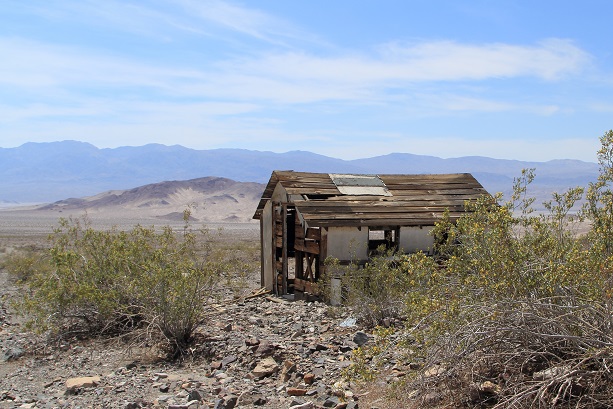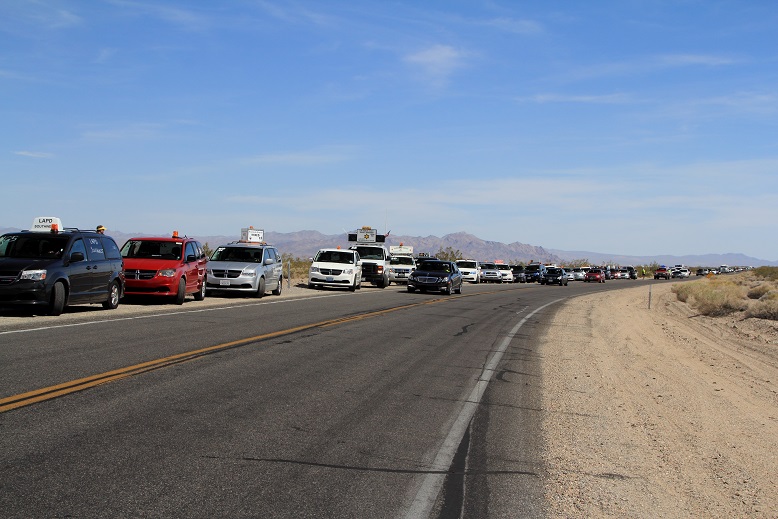After
leaving California State Route 127, the first few miles on the Ibex Springs
“Road” were a combination of sand washes and a rocky, rutted trail that was
passable with 2WD, at slow speeds. Then, we came to a washed out section of the
road that went steeply down a dry wash and an even steeper climb up the other
side. Time for 4WD!
Going
down the wash was easy, but trying to get up the other side was more
problematic because the ruts were so deep that it wasn't possible to keep enough wheels on
the ground at the same time to get any traction. (I’ve learned from experience that 4WD works best
when you keep all 4 wheels on the ground. When you get tires on alternate
corners of the vehicle off of the ground at the same time, and you don’t have limited-slip
differentials, you are not going anywhere, even with 4WD.) When you find yourself
in this situation, you have two options – get out and fill in the ruts with
rocks, or back your vehicle up the hill and then go as fast as you can up the other side to
bounce over the ruts. Since I decided to do the latter, part of the family
decided to get out and watch, while Kolohe decided to ride along – only to
throw a Big Gulp size cup of ice water all over the inside of my vehicle while bouncing over the ruts. Just to make me feel better, she informed me that
she also got soaked. (On the way home we had the same problem keeping all four
wheels on the ground at the same time; but with the help of gravity, we didn’t
have to drive as fast going down the hill.)

Ibex Springs History: In 1881 two young miners discovered outcrops of silver and copper near what is now known as Ibex
Springs and with no proven mineral deposits (other than the surface veins) they
sold their mining claims to a Chicago syndicate in 1882 for $48,000 (a lot of money for
that time period). In 1883 a five-stamp mill was constructed and a fifteen-inch-wide vein was opened to a depth of
80 feet, with ore assaying at $300 a ton. However, finding wood and water to operate the mill hampered ore
processing. A small smelting furnace was constructed in 1884, but it only
operated occasionally because of the lack of fuel and workers had a difficult time working in the intense summer heat.
In 1889 all mining activity in the area ceased and Ibex Springs was abandoned.
Then,
in the 1930s talc was discovered at the Moorehouse, Monarch, and Rob Roy claims
a short distance away and Ibex Springs was resurrected. However, because of its
asbestos content, talc fell out of favor as a baby powder and the market for
talc completed vanished by the mid-1960s. (I remember when we were kids our
Mother use to slap talcum powder all over us – it’s a wonder we all don’t have
mesothelioma.)
The
drive back to the highway was uneventful, but as we approached civilization, we
could see a long line of cars on the highway. My family quickly put on
their seat belts because they were certain that we were approaching some type
of police road block. I assured them that it was just road construction and
there was nothing to worry about because there wasn’t a policeman within 50 mile of
where we were at. Much to my surprise, when we arrived at the highway there
were law enforcement agents everywhere. Of course, my family immediately accused me of
being wrong, but I explained that technically I wasn't wrong - I was actually right, because I said that
there wasn’t “a” policeman within 50 miles , which is singular, meaning one. As it turned out, there were 8,000 law enforcement agents
participating in the annual Baker-to-Vegas 120 mile relay race. The race is
billed as “the world’s most prestigious and unique law enforcement foot
race…Starting in Baker, California and ending in Las Vegas, Nevada, law
enforcement officers from around the globe battle it out every Spring for the
chance of winning the coveted cup trophy.” (Check out their "B2V" web site for more
information.) With cars lined up as far as we could see in both directions, it was like being stuck in a Los Angeles traffic jam in the
middle of the Mojave Desert; so, we decided to call it a day and head for home (by way of Baker because
that was the opposite way the runners were traveling).














No comments:
Post a Comment